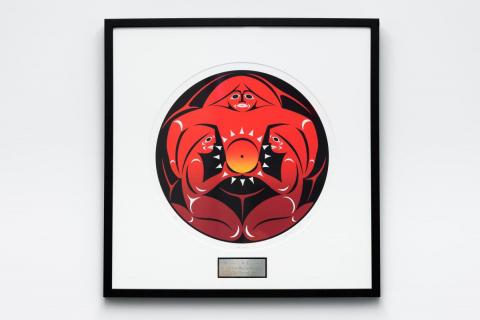The Faculty’s Allard Hall building project benefited from extensive consultation with representatives of the Musqueam Indian Band, on whose traditional and ancestral unceded territory UBC is located, and with other Indigenous faculty, staff and students. Allard Hall includes several features designed to reflect Musqueam culture and the role of Musqueam as hosts to visiting Aboriginal and Indigenous faculty, staff and students, and all others who come here. Musqueam welcomes all Indigenous peoples to share and contribute to this unique place.
Indigenous Law Student Lounge
The Faculty’s commitment to support Indigenous law students is reflected in part by the creation of the Indigenous Student Lounge. The purpose of the Lounge is to provide a place for Indigenous students to study and connect. The Allard School of Law and its Indigenous Legal Studies Program are committed to promoting education and research about Indigenous legal issues for use by lawyers, judges and the broader community. With strong support from the faculty, staff and students associated with the Indigenous Legal Studies Program, the Faculty recruits and supports Indigenous law students, offers courses in Aboriginal and Indigenous law, conducts research, often in partnership with Indigenous peoples and nations, provides legal assistance to Indigenous peoples through its clinic in the Downtown Eastside, and generally fosters greater understanding of the place of Indigenous peoples in Canadian society and abroad.
The Indigenous Student Lounge features ‘woven’ wood to represent the cultural importance and many uses of cedar. The display case in the wall of the Indigenous Student Lounge includes blades of grass between the glass as another recognition of the Musqueam Indian Band as ‘the People of the River Grass’. From the Lounge, students can see the word ‘xʷǝn̓iwǝn’ (for ‘remember’) in Musqueam’s hən̓q̓əmin̓əm̓ dialect emblazoned on a bench by the rainwater-fed reflection pool. Also visible from the Lounge is the House Post of ‘qiyǝplenǝxʷ’ (‘Capilano’)* by Musqueam artist Brent Sparrow Jr. This welcoming figure, representing an important Musqueam leader who maintained a fortified warrior outpost in this area, stands on the north side of Allard Hall, looking out over the Salish Sea and the north entrance to campus, as the original qiyǝplenǝxʷ and countless Musqueam before have done for centuries. It also serves to recognize the historic and ongoing relationship between the Allard School of Law and the Musqueam people in the pursuit of justice and education related to Indigenous peoples.
We are grateful to those who participated in the Faculty’s consultation process to create this special space as part of Allard Hall and we raise our hands in thanks.
hay ce:p q̓ə.
*not a true phonetic translation of this honourable name which continues to be passed down from generation to generation.
‘xʷǝn̓iwǝn’ (for ‘remember’) in Musqueam’s hən̓q̓əmin̓əm̓ dialect emblazoned on a bench that can be viewed from the Lounge.
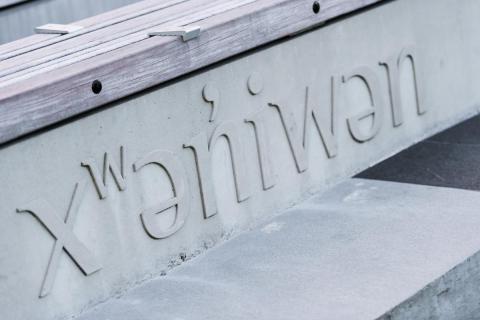
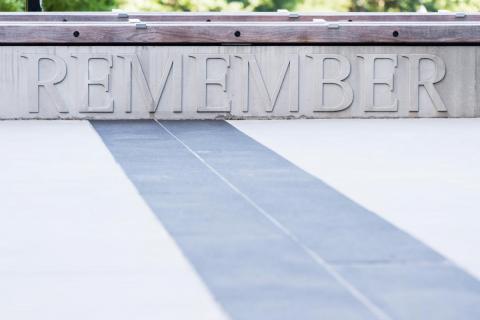
Art displayed in Indigenous Lounge includes:
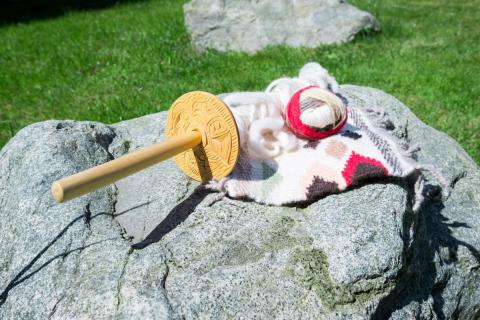
Musqueam Spindle and Whorl by Frances Guerin, Ramsay Louis, and McGary Point - located in the display case in the Lounge, Ground Floor
The tapestry, spindle whorl and the wool were crafted by Musqueam artists and brothers Ramsay Louis, carver, and McGary Point, weaver. Frances Guerin is the conceptual artist who used oral tradition to draw the integrated components of this art piece into a conceptual whole and she is the mother of Ramsay and McGary. This work was created circa 2003.
The spindle whorl depicts a link that threads and intertwines Indigenous Peoples into the tapestry. Each figure on the spindle whorl symbolizes the interweaving of the relationship between the academic community, the students, and Indigenous Peoples. The action of the spindle whorl animates the images of the figures representing a cooperative relationship where they are working as one.
- The eagle symbolizes the eyes of the academic world which is visionary in scope and has the duty to warn us when we are out of balance. Eagle arcs like a rainbow and moves through the sky animating the Air to remind us that clean Air is sacred and essential to the survival of all people.
- The salmon symbolizes the student and the circle of life in the way it journeys through fresh water to salt water and then returns again to fresh water. In this same way the student is nourished by traditional values and knowledge of the Elders prior to beginning life’s journey. Like the salmon returning again to its life sources, students return to provide nourishment to Indigenous Peoples. By returning to fresh water the salmon reminds us that fresh Water is sacred and necessary to all people.
- The wolf symbolizes family and reminds us that order evolves from following the laws of honour and respect in family relationships. When families follow their own laws they can move freely among other families of Indigenous Peoples and their territories. When families of Indigenous Peoples live in peace and accord with natural law they are one with all living things in the air, in the water, and on Mother Earth.
The tapestry arising from the spindle whorl represents a protective shield to symbolize the way that Indigenous Peoples respect, honour, and take responsibility for their relationship to Mother Earth.
- The Four Corners pattern is a sacred symbol and represents a common thread in shared teachings of Indigenous Peoples.
- The herringbone symbol represents the free flowing pattern of the water, wind, knowledge and teachings of our ancestors. Embedded in this pattern is the concept of Caution. To quote an Elder, “you must think first about what it is that you are going to do or say, for, like the wind, you cannot take it back”.
- The colours emanating from the tapestry are from natural representations from life; the flora and fauna that encompass all life.
The base represents the sacred ground we walk on: our Mother, the Earth that holds us up and nourishes us.
The spindle, the whorl, and the wool represent a work in progress, and thus the potential of the academic community, the students, and Indigenous Peoples working in a cooperative relationship.
Information found on a pamphlet for the Centre for International Indigenous Legal Studies (CIILS), sponsored by the First Nations Legal Studies Program (now the Indigenous Legal Studies Program) and the Faculty of Law, UBC and affiliated with the First Nations House of Learning, UBC. The tapestry and spindle were crafted as the CIILS program logo. CIILS was created in 1998 and the pamphlet predated March 2003, so I have dated these pieces as circa 2003.
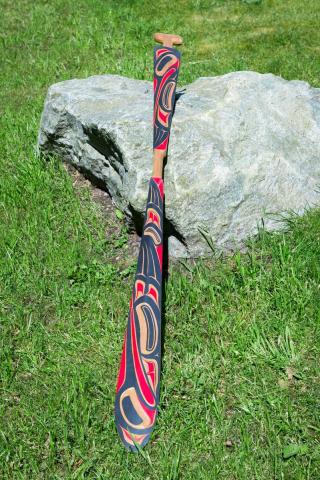
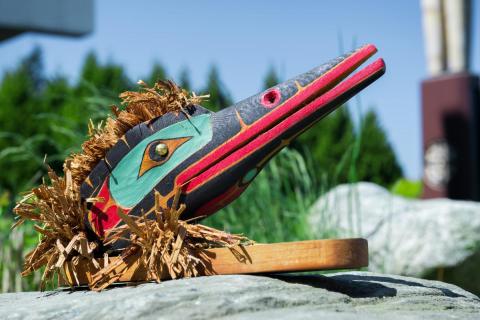
House Post of qiyǝplenǝxʷ
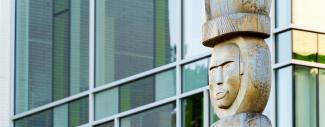
Also visible from the Lounge is the House Post of ‘qiyǝplenǝxʷ’ (‘Capilano’) by Musqueam artist Brent Sparrow Jr. This welcoming figure, representing an important Musqueam leader who maintained a fortified warrior outpost in this area, stands on the north side of Allard Hall, looking out over the Salish Sea and the north entrance to campus, as the original qiyǝplenǝxʷ and countless Musqueam before have done for centuries. It also serves to recognize the historic and ongoing relationship between the Allard School of Law and the Musqueam people in the pursuit of justice and education related to Indigenous peoples.
On March 20th, 2012 a group of 75 faculty, staff, students, alumni and friends gathered in front of Allard Hall to honour the newly raised First Nations Musqueam House Post. Brent Sparrow Jr. was commissioned to carve this house post. The ceremony also included a traditional Coast Salish blessing. Thelma Stogan, a respected member of the Musqueam Nation, bless the post using cedar boughs.

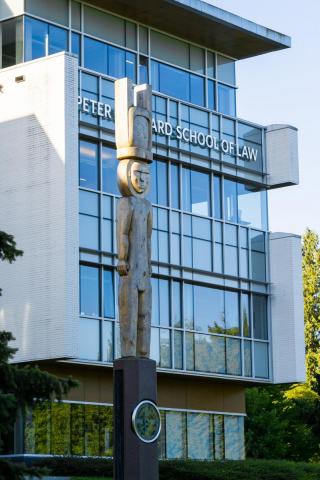
Indigenous Classroom
The Allard School of Law is a leader in Indigenous legal education in North America. Hundreds of Aboriginal students have graduated from the Faculty since Alfred Scow (Kwicksutaineuk Nation, LLB 1961, LLD 1997) led the way. Dr. Scow was the first Aboriginal person from British Columbia to earn a Bachelor of Laws, practice law and receive a judicial appointment. Dr. Scow is widely celebrated for performing a major role in educating non-Aboriginal people about the legal, cultural, social and historical issues facing Aboriginal peoples.
The Faculty is committed to the promotion of understanding of Indigenous legal issues and the education of lawyers and jurists in the nature of the relationship between Canadian society and Indigenous peoples. The Indigenous Legal Studies Program recruits and supports Aboriginal law students, promotes the development of courses in Aboriginal and Indigenous law, conducts research (in partnership with Indigenous peoples and nations), oversees the provision of legal assistance to Aboriginal peoples through its clinic in the Downtown Eastside, and generally fosters greater understanding of the place of Indigenous peoples in Canadian society and abroad.
The Indigenous Classroom was created as a space that fosters respect for Indigenous legal traditions; Indigenous knowledge mobilization, transmission and acquisition; and comparative discourses in law. It also marks a commitment to a diverse law community that honours Indigenous law students, faculty, staff and alumni presence and participation in the law school.
Indigenous Art
Sacred Circle by Dylan Thomas – located in the Terrace Lounge, 4th Floor
This piece was presented to Dean Mary Anne Bobinski by The Honourable Steven L. Point, OBC, Lieutenant Governor of British Columbia, to commemorate the opening of Allard Hall on September 23, 2011.
“This University, this Faculty, enjoys an international reputation which must be handed from one generation to the next. It’s not built on brick and stone but it’s built on ideas. It’s built with the energy and the intellect of those participants in this University and particularly in this law school.
This Faculty and University have saw fit to set aside space for the development and growth of Aboriginal concepts in law. Place this gift in Allard Hall as a reminder of this new beginning but also my thanks for this wonderful notion and idea of Aboriginal space in this amazing facility.” ~ Steven. L. Point
Dylan Thomas (Qwul’thilum) is a Coast Salish artist from the Lyackson First Nation. Dylan has apprenticed under renowned Kwakwaka’wakw artist Rande Cook, in all mediums of the art. Dylan’s other artistic influences have been Susan Point, Robert Davidson, and the late Art Thompson.
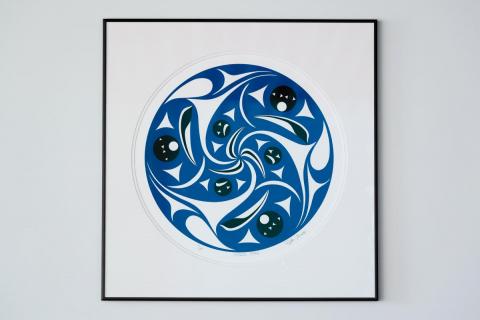
Eagle Mask by Lyle Wilson – located in the Law Library, 3rd Floor
This mask was donated by Mr. Peter A. Allard, QC on January 22, 2015, the same day the Faculty was renamed the Peter A. Allard School Law in recognition of Mr. Allard's transformational $30 million gift.
The Eagle Mask, carved by artist Lyle Wilson in 1989, represents the ancestral crest of the Eagle Clan of the Haisla people in Kitamaat, BC. Inspired by eagles and the Haisla people's admiration and adoption of many traits of the bird, Wilson says he was influenced by Haisla art in his formative years. The Eagle Mask represents the universal characteristics of pride, beauty and ferociousness. The feathers are carved from yellow cedar in the artist's effort to preserve real eagle feathers.
Lyle Wilson was always conscious and appreciative of Haisla art, but did not pursue art as a possible profession until he attended UBC. At that time he committed to a career in art, leading to further education at the Emily Carr University of Art and Design. For many years, he was the Artist in Residence at the UBC Museum of Anthropology. Eagle Mask was acquired from the Inuit Gallery of Vancouver, Ltd.
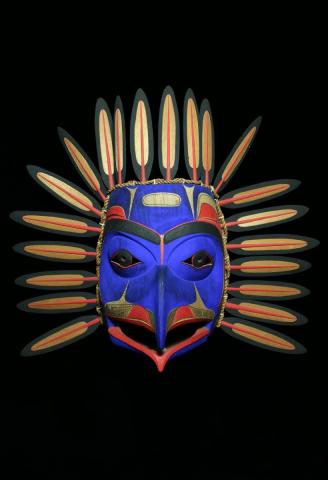
Gaining the Power of the Moon by Klatle-bhi – located near the entrance to the Law Library, 2nd Floor
The Allard School of Law gratefully acknowledges Peter M. Brown, for providing this gift of art in honour of his uncle, Douglas McK. Brown.
Born in North Vancouver in 1966, Klatle-bhi began his life as an artist studying the works of his ancestors featured in museums and galleries. In his carvings, he is committed to the spiritual and cultural expression of his ancestors. Klatle-bhi comes from a traditionally rooted family where his Squamish and Kwakwaka’wakw cultures are a large part of everyday life. He believes both art and culture meet on a journey into the history of his people. He has taken on several apprentices to share the knowledge and experiences passed down to him with the next generation of artists. His artwork can be found in several public museums and private collections throughout the world.
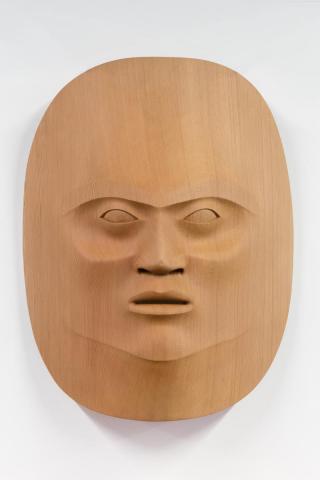
Jetsons, Greenland, 2018 by Dawna Mueller – located outside the Dean’s office, 2nd Floor
The Allard School of Law gratefully acknowledges Dawna Mueller and Back Gallery Project for providing this gift of art.
Alumna Dawna Mueller is recognized for her work in bringing attention to the effects of climate change on the natural ecosystems of the world’s remote polar and alpine regions. Jetsons is part of a collection entitled Anthropocene – Vanishing Landscapes.
Mueller’s interest in the confluence of conservation and photography began while working in the Yukon driving heavy machinery to finance her studies at UBC. After moving to Switzerland, Mueller studied photography and began documenting the changing nature of the Alpine landscapes due to climate change. This led to expeditions in both the Arctic and Antarctic where she witnessed exceedingly warming temperatures, disappearing glaciers and the adverse effects to the region’s wildlife. Mueller’s work shows these changing landscapes due to our human impact. She is the co-founder of a Swiss non-profit Society, Future Planet Forum, whose mandate is to bring science, art and business together to work towards solutions for a sustainable planet.
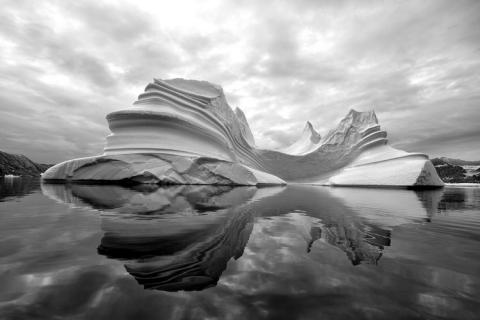
Salmon by Matthew Baker – located in room 143, Ground Floor
Matthew Baker is a Squamish Nation wood carver born in 1953 on the Capilano Reservation in North Vancouver, BC. His mother is Kwakiutl and his father is Coast Salish. Matthew was taught by his father Richard, a master totem carver and was taught to carve in the Kwakiutl style. He has now been carving for over 25 years.
Matthew carves plaques, masks, rattles and totem poles in traditional Coast Salish and Kwakiutl images that employ a traditional tri-color design on unstained wood. His crisp lines and elegant combination of animal forms has helped to distinguish him as a unique and talented artist. His art work can be seen in Art Galleries and Gift shops in the Vancouver area as well as private collections worldwide.
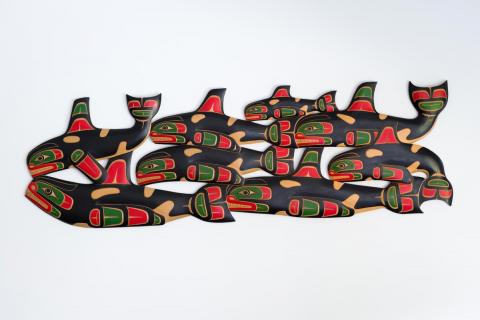
Legacy by Susan Point, OC, RCA – located adjacent to office 347, 3rd Floor
Susan Point began making limited edition prints on her kitchen table in 1981 while working as a legal secretary. She received several early commissions, which established her reputation for innovative proposals and for completing projects on time, on budget and at the highest level. She took courses in silver, casting and carving, all of which led to monumental sculptures in mixed media, and she was the first Northwest Coast artist to work in glass. She continues to release a number of print editions each year, but her focus has been on commissioned sculpture.
Beaver and the Mink was chosen as the gift from the Canadian government to the new addition to the Smithsonian Institution’s National Museum of the American Indian. She has several works in Vancouver International Airport, Langara College, the University of British Columbia Museum of Anthropology and the Victoria Conference Centre, and her designs have been the logo for the annual Pacific Spirit Run, a fundraiser for hospital charities in Vancouver. She has also sat on the board of the Emily Carr Institute of Art Design in Vancouver.
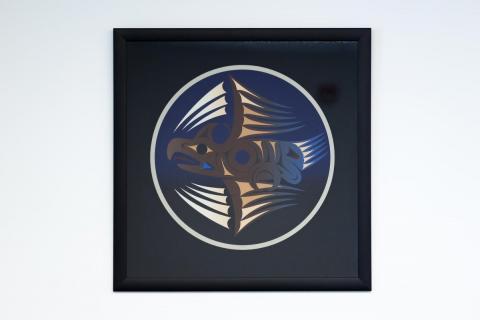
Alpha Wolf by Joe David - located adjacent to office 152, Ground Floor
Joe David is a Nuu-chah-nulth artist, a member of the Tla-o-qui-aht Band of the Nuu-chah-nulth people, formally "adopted" into the Haida people,whose work is identified with the contemporary Northwest Coast art movement; a singer of traditional Nuu-chah-nulth songs, and has a strong interest in shamanic traditions, both those from his own culture and from others.
David was born in the Clayoquot village of Opitsaht (on Meares Island off the west coast of Vancouver Island), attended art school in Texas and Seattle, and turned to Northwest Coast Native art after he was showcased by the Burke Museum collection of Northwest Native art.
He was one of the innovators of serigraphy featuring traditional Northwest Coast Native motifs, and has worked in a variety of media, including carving totem poles. His eclecticism has involved an interest not only in his native traditions and the broad mainstream of contemporary North American culture, but also in other Native American traditions and, for example, by Maori art. Rejecting the view that traditional Northwest Native cultures should somehow remain frozen in time, he has remarked "The fact is, there is always change and our people have always been comfortable with it." David has pieces in the permanent collections of the Metropolitan Museum of Art in New York City and in the Museum of Anthropology at UBC.
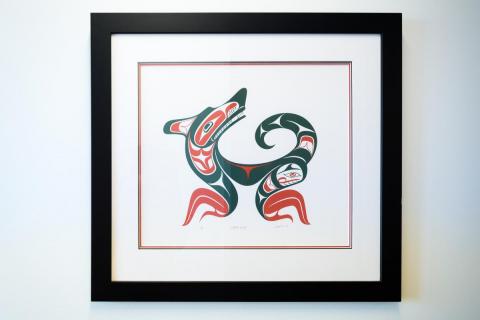
Our Spirit Soars – located in the Career Resource Centre room 153, Ground Floor
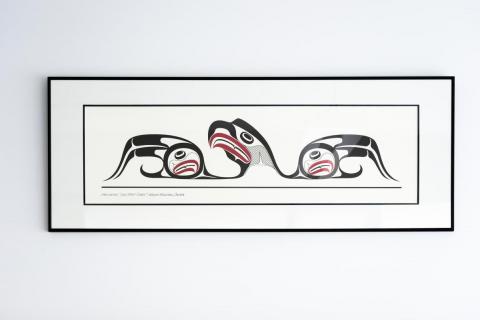
The Gift by Kelly Cannell - located in the Law Students' Legal Advice Program office, room 129, Ground Floor
Presented to the Faculty by the Class of 2011.
Kelly Cannell is a Coast Salish artist from the Musqueam Nation in British Columbia. Kelly was shown Coast Salish Art and culture from birth; she lives it every day among her community with her family, including her two children. As far as Kelly can remember is when she began to explore her calling in artistry. Her talents continue to grow in part from Kelly’s passion for travel, which brings her to countries around the world. Experiencing these places with the help of local cultures and their own unique culture have helped intensify her connections to the natural world. Kelly uses these experiences and connections as the foundation for all of her work.
In her pursuit for exploring mediums, she’s followed her passion for glass to the renowned Pilchuck Glass School in Stanwood, Washington, and The Glass Furnace in Istanbul, Turkey.
Kelly also continued to study part-time at Emily Carr University, most recently silk screen printing and acrylic painting. She takes pride redefining her style and perspective, and continues to challenge herself by expanding on traditional themes as well as teaching children.
Kelly is amassing public works throughout Vancouver including: Storm Sewer covers (with mother Susan Point) and sites at Canadian Broadcast Corporation (CBC), Vancouver Community College, Musqueam Community Centre, West Broadway, Westbank towers @ Granville & 70th and a Canada 150 Light Box Mural at Queen Elizabeth Theatre.
- Profile is found from Kelly’s personal website.
